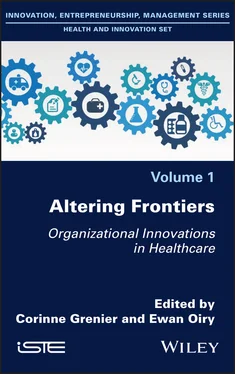3 3HPST: Hôpital, Patient, Santé et Territoire; Hospital, Patient, Health and Territory.
4 4CPTS: Communauté Professionnelle Territoriale de Santé; Professional Territorial Community for Health; GHT: Groupement Hospitalier de Territoire; Territorial Hospital Grouping.
5 5LFSS: Loi de Financement de la Sécurité Sociale; Law for the Financing of Social Insurance.
Introduction
The Challenges of “Altering Frontiers”: The Multiple Facets of Boundaries to Cross and Articulate
In most developed countries, health systems and organizations at first glance seem a kind of mystery to anyone wishing to understand their mechanisms and dynamics. Their challenges are well known, and meeting them is a challenge (aging population, rise in chronic diseases, technological upheavals made possible by the arrival of Big Data and artificial intelligence, financial equilibrium, increasing inequalities in access to healthcare and healthcare services, the desire for greater patient autonomy and the legitimacy of their voice and experiences, etc.). Conditions are identified as being reinforced by a system that is too procedural, losing its ability to respond in a personalized and individualized manner to the needs of its users and patients. It appears to be “ungovernable” through the usual channels when it comes to dealing with crises with sudden manifestations that are part of a complex network of causes (such as the COVID-19 pandemic or climate change).
Once this diagnosis has been made, the avenues for transformation have also been identified around the central priority of altering frontiers in a system that is too strongly compartmentalized: inventing new forms of governance and cooperation to counter the impossibility of doing things “collectively” in a pluralist system, and giving back room for maneuver and spaces for inventiveness and transformation to local stakeholders in the face of a system that is heavily top-down and has little trust and legitimacy in a number of stakeholders; and yet, health systems remain difficult to transform when there is an extraordinary number of experiments, creative approaches, local dynamics, organizational reorganizations, etc.
In order to go beyond this apparent paradox, it is necessary to adopt relevant viewpoints that broaden analytical perspectives that are conducive to transformation.
This is why the angle of this book is that of “altering frontiers”, at the micro (stakeholders), meso (various collectives, organized groups) and now macro (organizations) levels. Indeed, the expression “altering frontiers” offers different viewpoints, enabling the researcher and professional and institutional stakeholders to rethink what constitutes a boundary and to act on them in order to organize or coordinate activities differently. This book therefore proposes a new way of analyzing organizational innovations that aim to transform the healthcare system from a vertical and compartmentalized approach to a more horizontal and decompartmentalized one. This approach provides a multifaceted view of the drivers, favorable conditions and methodological principles that can support sustainable transformations in order to “rebuild institutions”.
I.1. Altering frontiers: a boundary concept
Thinking of innovation from a perspective of “altering frontiers” invites us, on the contrary, to invest in that which forms a boundary. Indeed, a boundary makes it possible to name, identify, make tangible or visible what is distinctive between what is inside or outside a “space” (Lamont & Molnar 2002). There are thus multiple dimensions (Zietsma & Lawrence 2010; Bucher & Langley 2016): social, relational, cognitive, symbolic, geographical, temporal, material, institutional, etc. (Zietsma & Lawrence 2010; Bucher & Langley 2016). From this perspective, innovation becomes opportune when crossing boundaries, and makes it possible.
Let us consider, for example, the new methods of intervention with the elderly that are currently emerging in France or in other countries and that are described by the still imprecise expression: EHPAD hors les murs (EHPAD 1 outside the walls). For such an establishment, it is a question of intervening in the homes of these people by relocating expertise there. The depth of the innovation is measured in terms of the different boundaries crossed: institutional boundaries between the establishment and the home or professional boundaries between the professions of the EHPAD and the home, for example. Some of the contributions in this book shed light on these crossed boundaries that are necessary to support innovation in the field of healthcare: with the emergence of a new “profession”, that of advanced practice nurses which, according to Philippe Mossé ( Chapter 2), attempts to create a new, autonomous professional space between the nurse and the general practitioner; with entry into the domain of the common stakeholders of care or support, of volunteers who, according to Bertrand Pauget ( Chapter 3), seek to make the most of their expertise, which is neither professional nor completely lay.
Another way of rethinking boundaries is to design new spaces conducive to innovation (Grenier & Denis 2017), taking the form of original structural reorganizations, which may be internal and/or external, and bringing together stakeholders from different services or structures. This is the case, for example, of teams reshaping their relationships and knowledge when, according to Delphine Wannenmacher ( Chapter 4), they use a new technology (surgical robot) to deliver care differently. In this chapter, the author shows in particular how much, with respect to this robot, visual communication (and associated skills) is reduced and the usual partitions (with regard to time and division of work) are no longer effective. In the same way, the creation of service clusters within hospitals constitutes, for Christelle Havard ( Chapter 5), a potential for transformation provided that the stakeholders can carry out cooperative work, at three levels: structural (at the level of the hospital as a whole, to divide and coordinate work), operational (at the level of a department, to organize care tasks around the patient) and trajectorial (around the patient to design and implement a care plan). Finally, we can cite the example of the PTA ( plateforme territoriale d’appui , territorial support platform), which organizes in an original way the coordination between so-called “front-line” professionals to provide a coordinated response to patients in complex situations. For Matthieu Sibé, Sandrine Cueille and Tamara Roberts ( Chapter 7), this organizational innovation will reach its full capacity to provide individualized solutions in the monitoring of trajectories if the stakeholders reinvent their relationships and governance according to the adhocracy model (Mintzberg 1993). This form reflects flexible organizations, combining multidisciplinary and crossdisciplinary skills, capable of adapting to the needs and constraints of the tasks to be accomplished. In this way, another lesson from the various contributions in this book is that the managerial and organizational innovation that accompanies the adoption of new intervention models, new tools or processes only produces its effects if the paradigms relating to modes of governance and decision-making are also transformed (Moore & Hartley 2008).
This calls for a look at a second point to think about innovation, enabled by the boundary concept: creating new networks of knowledge, insights and experience. One way is to introduce new stakeholders who will renew the cognitive reserve of those typically present. With reference to charitable workers working with older people in Sweden, Bertrand Pauget ( Chapter 3) examines the interest in encouraging the creation of communities of practice, henceforth called “managed communities” (Bootz 2015), to enable these stakeholders to exchange their experiences in order to improve or even transform them. Focusing on patients, Luigi Flora ( Chapter 1) relates the original experience of the “UniverCité” of patients, based in the south of France (Nice). The latter is inspired by similar Quebec models, and brings together health professionals, patients, caregivers, users and civil society to develop experiential knowledge about care, particularly about chronic diseases. It is a double innovation that is thus introduced: the recognition of patients’ knowledge and the recognition of experiential knowledge.
Читать дальше










